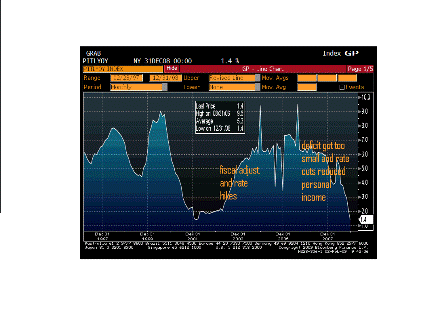The Swiss have been buying euro all along to support their exporters (at the expense of the macro economy but that’s another story).
No doubt other nations are/will do same, also to protect exporters, and do the best they can managing risk of their euro denominated financial asset portfolios.
Over the last two years or so the ‘automatic stabilizers’ in the euro zone added to deficits and weakened the currency, helping to support domestic demand and exports, but threatening solvency as the national govts are credit constrained.
The credit constraint aspect blocked further fiscal easing, and caused a proactive move toward fiscal tightening.
If the easing phase was sufficient to cause them to ‘turn the corner’ with regards to GDP, which appears to be the case, it is possible GDP growth can remain near 0 with the austerity measures, while the firming currency works to slowly cut into exports.
In other words, the euro zone may, in its own way, also be going the way of Japan, but with the extreme downside risk that the austerity measure cut too deep and the deflationary forces get out of hand, as they are flying without a fiscal safety net.
Switzerland’s Gerber Sees ‘Hope’ of SNB Countering Franc Gains
By Simone Meier
June 4 (Bloomberg) — Jean-Daniel Gerber, the Swiss
government’s head of economic affairs, said he’s counting on the
central bank to counter any “excessive” gains of the franc to
protect the country’s export-led recovery.
“I’m of course concerned” about franc gains, Gerber, who
heads the State Secretariat for Economic Affairs, told Cash in
an interview published on the newspaper’s website today. “But
there’s hope that the SNB will be able to keep its promise of
countering an excessive appreciation of the franc.”
The Swiss currency has been pushed higher on concerns that
a Greek debt crisis will spread across the 16-member euro region
and hurt an economic recovery. The Swiss National Bank has
countered franc gains by purchasing billions of euros at an
unprecedented pace to protect exports and fight deflation risks.
The franc today breached 1.40 per euro for the first time
since the single currency was introduced in 1999. It
strengthened to as much as 1.3867 against the euro, trading at
1.3942 at 3:29 p.m. in Zurich.
Gerber said that while it’s “up to the central bank” to
decide on the extent of currency purchases, the SNB’s ability to
counter franc gains is “theoretically unlimited.”
“You can always counter an appreciation if you want to,
you just have to inject money into the market, purchase euros,
and that’s how you’re able to stabilize the value of the franc
versus the euro more or less,” he said. “But of course it
could have considerable negative side effects, namely of larger
liquidity sparking inflation if it isn’t re-absorbed.”


